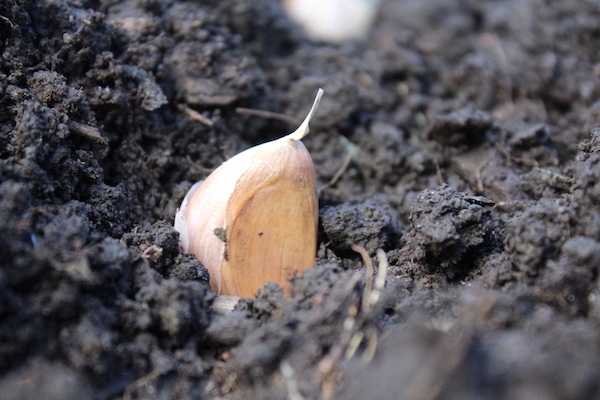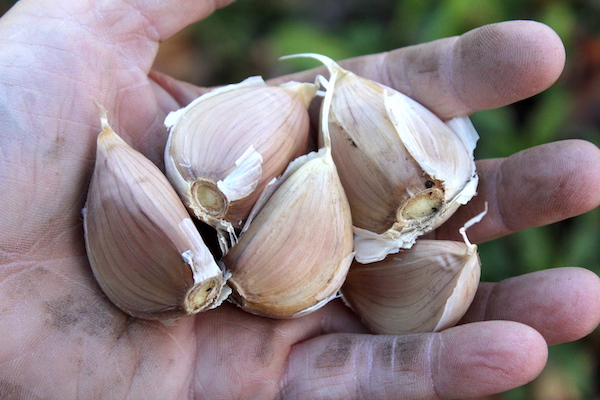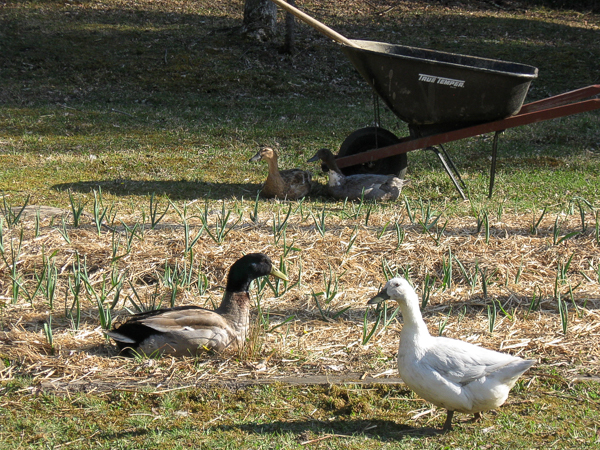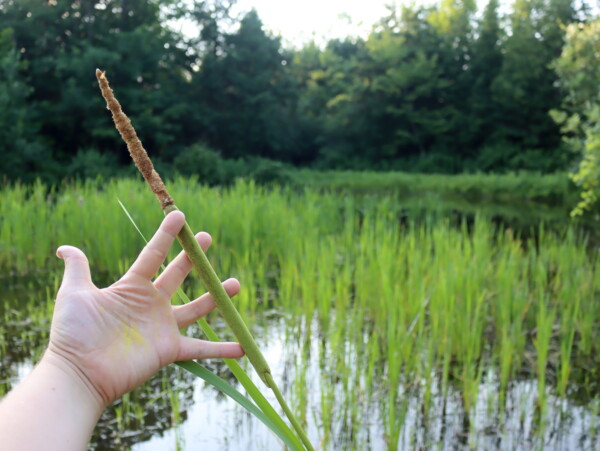Affiliate disclosure: This post may contain affiliate links. Please see our Privacy Policy.
While most of the garden is getting put to bed, garlic is just getting started. Planting garlic in the fall may seem a bit backward, but it’s the best way to ensure a good crop the following year.

Most garden veggies are tender annuals, planted in the spring after danger of last frost. Garlic is a perennial and planting garlic in the fall allows the bulbs to get established so that they’ll be ready to grow just as soon as the snow melts in the spring.
When to Plant Garlic
The best time to plant garlic in the fall depends on your location. Garlic should be planted 4 to 6 weeks before the soil begins to freeze for the winter.
In Vermont (zone 4), that’s earlier than most places in the US because winter comes early. I plant garlic in Mid-October because the soil usually freezes by Thanksgiving.
In far northern locations such as Canada and zone 3 regions of the US, plant garlic at the beginning of October. In areas further south, garlic is planted as late as Mid-November.
While I’d love to give you an exact date, it’s not quite that simple. Really though, there’s a lot of gray area in planting garlic.
Some years I’ve planted garlic as early as late September to accommodate a busy fall ahead, and other years I don’t get it in the ground until November. Every year, the crop comes in without fail. Garlic is less picky than you’d think.
Choosing Garlic to Plant
More important than when to plant garlic is choosing the best seed garlic. Look for bulbs that have a tight papery wrapper that’s completely intact. Cloves that are splitting or not holding together won’t store well, and if you plant those, the garlic you harvest will share those characteristics.
Ideally, find the largest cloves possible for planting. Planting large cloves means that the garlic plants have extra energy to produce extra-large bulbs the following year. It also means that the garlic you harvest will have large cloves, making peeling easier in the long run.
Beyond just selecting the largest cloves for planting, the specific garlic variety will impact the flavor and the growth habit of the plants. There are more than 200 commonly grown garlic varieties, and each type has been selected to thrive in a particular region. Try to find high-quality seed garlic locally if you can, and save your own bulbs once you have a successful strain.

Preparing Garlic Bulbs for Planting
Once you have seed garlic in hand, the bulbs will need to be peeled to separate the individual cloves. It’s important to just remove the outer papery husk and leave the inner garlic peels intact. This helps protect the seed garlic cloves from damage during planting.
Gently start peeling down the outer peel from the top of the bulb, removing just as many layers as is necessary to reveal the individual cloves. Once you have a bit of practice this only takes a few seconds.

How to Prepare a Garlic Bed for Planting
In ideal conditions, garlic prefers rich, well-drained soil that’s largely free of rocks and stones. Cultivate a bed to remove roots, sticks and stones that may deform growing garlic. Add in screened compost to create a rich, well-cultivated and weed-free planting bed.
That said, in addition to a dedicated garlic bed, I also plant garlic just about anywhere around the yard to help deter pests. A few bulbs go under young apple trees in the orchard, and others grow interspersed with perennials and herbs in my flower gardens. They all produce tasty garlic, though the bulbs planted in less than ideal conditions tend to be ever so slightly smaller.
How Far Apart to Plant Garlic
Garlic spacing requirements are a bit subjective. Some sources say to plant bulbs as close as 4 inches apart in rows 8 inches apart.
Others suggest 6 to 8 inches apart in rows at least 1 foot apart. Planting further apart means there’s more space for individual bulbs to grow larger and access more nutrients, but it also means that there’s extra space for weeds.
In dry areas, planting further apart will reduce the need for irrigation. Water is rarely a problem here in Vermont, and we produce plenty of compost. In rich soil where water is not an issue, 4 inches apart in rows 8 inches apart maximizes your garlic harvest.
How to Plant Garlic in the Fall
While garlic isn’t picky in general, the direction of planting is important. Garlic planted upside down will be deformed and stunted, if it grows at all. The most important thing about planting garlic is ensuring that it’s planted root side down and stem side up.

Softneck garlic varieties don’t care as much about planting direction, and that means they can be planted mechanically. That’s why you’ll usually only find softneck garlic growing in the grocery store.
It’s a shame because the best tasting garlic is the hardneck varieties. Softneck garlic is mild, with very little flavor by comparison.
Plant individual cloves 4 to 8 inches apart, in rows 8 to 12 inches apart. Allow for more space in dry, poor soil.
Above all, make sure they’re pointed in the right direction. Look at where the tiny roots are on the seed garlic bulb and let that be your guide.
Cover each clove with 1 to 2 inches of soil, ideally deeper in colder climates. After that, cover the entire bed with a generous blanket of straw or dry leaves. The garlic cloves will get established and just begin to sprout before winter really sets in, and then they’ll sprout again very early in the spring.
How to Care for Garlic Plants
The fall-planted garlic will sprout again once the snow melts in the spring and begin growing vigorously. Be sure to keep the bed mulched and weed-free.
Our free-range ducks were a great help with the garlic because they love the bugs and weeds, but wouldn’t eat the actual garlic. They, unfortunately, eat just about everything else, so they’re only really garden helpers around the garlic bed.

Removing Garlic Scapes
In early June, the fall-planted garlic will begin to produce garlic scapes. A garlic scape is the curly flower stalk of a hardneck garlic plant, and they’re not really a concern with softneck varieties.
Many home gardeners hate the chore of removing the scapes, while others think of them as an early bonus harvest. It’s all about perspective.
We harvest them for garlic scape pesto and pickled garlic scapes, which taste a lot like dilly beans. If you leave them on they’ll develop into small garlic bulbils, which are true garlic seed. You can plant bulbils and grow garlic from seed, but letting the plants go to seed means they won’t put all their energy into growing large bulbs.
A good garlic harvest means removing scapes, but don’t worry if you miss one or two. It’s not the end of the world, the bulb will still form below the soil, it’ll just be a bit smaller.

Harvesting and Curing Garlic
Garlic is harvested in July in most locations, once the leaves start to brown and die back. Gently pull up each bulb and dust off as much dirt as you can. Don’t wash them, and be careful not to bruise the bulbs.
Leave the roots and leaves intact, all the energy from the plant material will go into the bulb as it cures. Hang the garlic or spread it out on a table out of direct sunlight and protected from rain. Ideally, it’d be in a well-ventilated breezy area that’s 75 to 80 degrees.
It takes about 2 weeks to cure garlic, but it can take longer in poor drying conditions. Once the outer peel is dried down and the tops are good and brown, cut the bulbs off and store the garlic in a cool dry location like the pantry.

At this point, the whole process starts all over again. Sort through your garlic harvest and find the largest, healthiest bulbs.
Save those to the side as your seed garlic for the fall. Those cloves will be stored until planting time 4 to 6 weeks before the soil freezes.
If you select the very best cloves year after year you’ll develop your own strain of garlic, perfectly selected for your local growing conditions.





Hello , great page love all the information on your page !
But Quick question, do you water after planting the bulbs before you put the mulch on ?
You can water and then mulch or mulch and then water. I don’t think it makes much of a difference.
I didn’t know I had to take off the scapes. The plants come back on their own year after year, but I don’t get the big garlic bulbs, just the clusters of small seeds on top, I guess that’s why. I live in southwest Washington state, where the climate is generally mild. Should I buy new bulbs to plant this year? Thanks.
The purpose of removing the scapes is to allow the garlic to put its energy into growing the bulb rather than the scape. If you remove the scapes you will get a bigger bulb. You should be able to plant the bulbs that you have.
You mention that garlic helps deter pests. Would you know if it will keep chipmunks away?
Garlic is commonly used to keep chipmunks, either by planting it in the area that you wish to deter them or by making a spray of pureed garlic and/or peppers steeped in hot soapy water to use directly on your plants.
I have an amusing garlic story. We bought a farm with garlic growing wild in a pasture. The cattle grazed all spring ignoring the garlic until one day I noticed a tussle around my intended harvest. All the green was gone. When I entered the barn that night, the stench from a small herd belching and repeatedly swallowing their treats was something ill never forget,
Ha! I’ve heard onions and garlic in cattle feed changes the flavor of the milk too, but I’d never thought about the burps!
Thank you. How do you remove the scape? Cut to the bottom or just the rounded part ?
Thank you for this detailed instruction. I’m a senior citizen who loves learning about how to do the things I’ve never done. My biggest feat has been canning tuna the past 4 years! Living on the Oregon Coast where fresh tuna is plentiful each summer I learned to do this before I had canned anything in my life. Thanks to You-tube demonstrations about how to use a pressure cooker. I feel so smart!!
It was my pleasure!
What are the times for zones 3-4
Ashley mentions in the article that she is in zone 4 and plants in mid-October so you should be able to plant around the same time.
Thanks, this was great. I want to save garlic to plant, and wonder what is the best way to store it?
You just need some place that is fairly cool, dry and out of direct sunlight. Since you are planting it in the fall, there really isn’t a whole lot of time between harvest and planting.
Very informative, thanks.
You’re welcome!
Do you recommend planting garlic in the same bed every year, replenishing with compost and manure….or rotating garlic beds?
I always try to rotate all of my crops whenever possible. While it isn’t absolutely necessary, it greatly reduces the risk of pests and disease.
Thanks for this. Love that you are in Vermont. I live close by in Burlington…lol. Question, this piece does not mention how much sun garlic needs? Full, part shade? Thanks the help.
Your garlic will grow best in full sun.
I live in zone 6 or nothern Ohio near lake Erie. I read that hard neck garlic is better to grow here. But I would like to grow soft neck here. I read that softneck is for warmer zones. Would you advise that I grow hardneck here? Vermont is similar. What kind of Softneck and hardneck do you recommend for my area and where can I ourchase on line?
I enjoyed reading your web page and will recommend to others. Thank you.
KEEP ON GROWING.
I bought my seed garlic from https://filareefarm.com/ this year. They had a great variety and also a lot of really good information and education on their website. You might want to check it out. Soft neck might be better for warmer zones but it would probably do fine for you there as well. I ordered 4 or 5 different varieties to try. You might want to try a little of both and see how they do.
Good, concise , straightforward information…thank you!
You’re welcome!
Thanks for this information ,I’ll be following your advice.
Thanks for this information. Judy